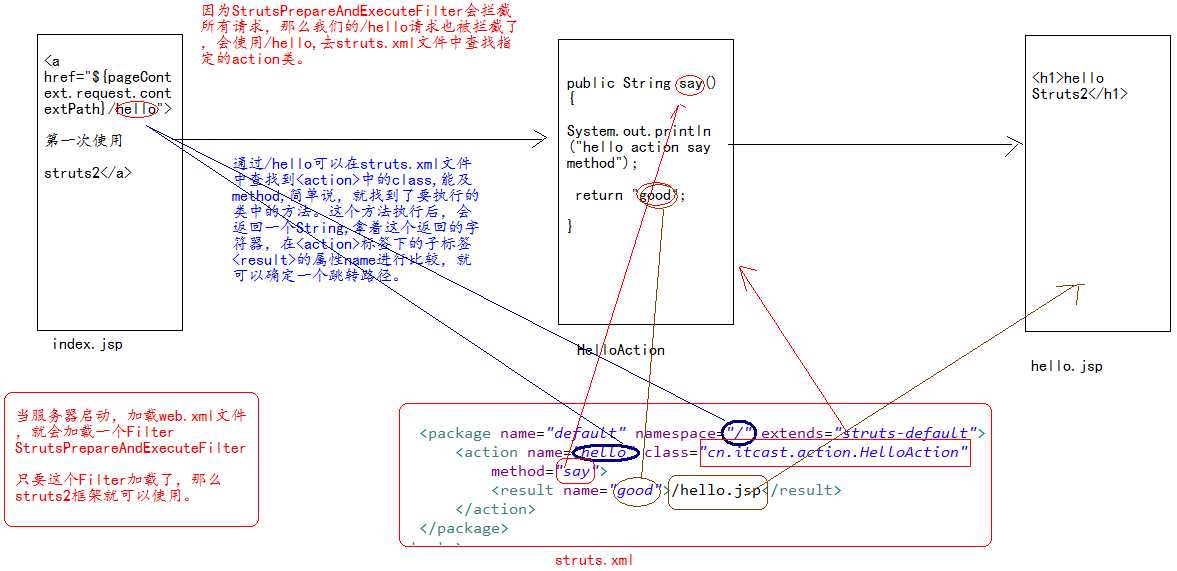标签:turn 文档 代码 web.xml str 地址 style attr org
struts2快速入门:
index.jsp------>HelloAction--------->hello.jsp struts2流程
1.导入jar包
struts2的目录结构:
apps: 例子程序
docs:文档
lib:struts2框架所应用的jar以及插件包
src:源代码
core 它是struts2的源代码
xwork-core struts2底层使用了xwork,xwork的源代码
注意:在struts2开发,一般情况下最少导入的jar包,去apps下的struts2-blank示例程序中copy
2.创建index.jsp页面
创建hello.jsp页面
3.对struts2框架进行配置
1.web.xml文件中配置前端控制器(核心控制器)-----就是一个Filter(目的:是为了让struts2框架可以运行。)
<filter> <filter-name>struts2</filter-name> <filter-class>org.apache.struts2.dispatcher.ng.filter.StrutsPrepareAndExecuteFilter</filter-class> </filter> <filter-mapping> <filter-name>struts2</filter-name> <url-pattern>/*</url-pattern> </filter-mapping>
2.创建一个struts.xml配置文件 ,这个是struts2框架配置文件(目的:是为了struts2框架流程可以执行。)
名称:struts.xml
位置:src下(classes下)
4.创建一个HelloAction类
//要求,在HelloAction类中创建一个返回值是String类型的方法,注意,无参数。 public String say(){ return "good"; }
5.在struts.xml文件中配置HelloAction
<package name="default" namespace="/" extends="struts-default"> <action name="hello" class="cn.itcast.action.HelloAction" method="say"> <result name="good">/hello.jsp</result> </action> </package>
6.在index.jsp中添加连接,测试
<a href="${pageContext.request.contextPath}/hello">第一次使用struts2</a>
在地址栏中输入:http://localhost/struts2_day01/index.jsp 访问连接,就可以看到HelloAction类中的say方法执行了,也跳转到了hello.jsp.
运行流程:

用filter模拟Struts2工作原理:
public class StrutsFilter implements Filter { public void init(FilterConfig filterConfig) throws ServletException {} public void destroy() {} public void doFilter(ServletRequest req, ServletResponse resp, FilterChain chain) throws IOException, ServletException { // 1.强转 HttpServletRequest request = (HttpServletRequest) req; HttpServletResponse response = (HttpServletResponse) resp; // 2.操作 // 2.1 得到请求资源路径 String uri = request.getRequestURI(); String contextPath = request.getContextPath(); String path = uri.substring(contextPath.length() + 1); // 2.2 使用path去struts.xml文件中查找某一个<action name=path>这个标签 SAXReader reader = new SAXReader(); try { // 得到struts.xml文件的document对象。 Document document = reader.read(new File(this.getClass().getResource("/struts.xml").getPath())); // 查找<action name=‘hello‘>这样的标签 Element actionElement = (Element) document.selectSingleNode("//action[@name=‘" + path + "‘]"); if (actionElement != null) { // 得到<action>标签上的class属性以及method属性 String className = actionElement.attributeValue("class"); // 得到了action类的名称 String methodName = actionElement.attributeValue("method");// 得到action类中的方法名称。 // 2.3通过反射,得到Class对象,得到Method对象 Class actionClass = Class.forName(className); Method method = actionClass.getDeclaredMethod(methodName); // 2.4 让method执行. String returnValue = (String) method.invoke(actionClass.newInstance()); // 是让action类中的方法执行,并获取方法的返回值。 // 2.5 使用returnValue去action下查找其子元素result的name属性值,与returnValue做对比。 Element resultElement = actionElement.element("result"); String nameValue = resultElement.attributeValue("name"); if (returnValue.equals(nameValue)) { // 2.6得到了要跳转的路径。 String skipPath = resultElement.getText(); request.getRequestDispatcher(skipPath).forward(request,response); return; } } } catch (Exception e) { e.printStackTrace(); } // 3.放行 chain.doFilter(request, response); } }
标签:turn 文档 代码 web.xml str 地址 style attr org
原文地址:http://www.cnblogs.com/fengmingyue/p/6117224.html